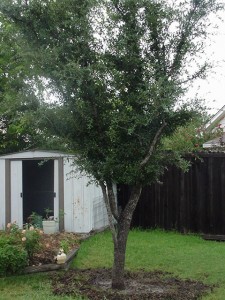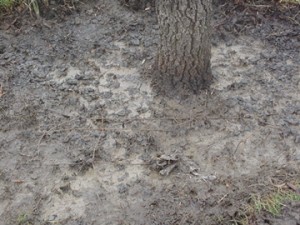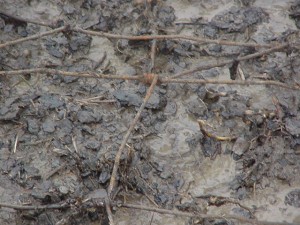It was a little overwhelming moving from a house with a lot of structure in the yard to a completely blank canvas.
Well, OK. It wasn’t completely blank. In the back yard, there was a raised area inside of landscaping timbers but it was all grass. There were also two Live Oak trees, but they were not healthy. In fact one of them was very sick. We found out later that there had been a series of three pairs of Live Oak trees attempted there. When the spring rains came and we had “Lake Fierke” in our back yard, I started to take a closer look.
When you plant a tree, you need to make sure that you don’t plant it too deep and cover the ‘root flair’. Picture, in your mind, the pencil drawing of a ‘tree’ and you can see at the bottom how it flairs back out a little bit. That is the way a tree is supposed to look. If it is a straight line all the way to the ground, it was planted too deep and the tree will suffer. So, I could tell that our tree was planted too deep and now with all the water I knew it was in real trouble, so I decided to take up my shield and sword and save the fair tree.

Sick Live Oak Tree
OK, so it was a shovel and not a sword. It is hard to tell from this picture just how sick the tree was, but it really was not good. I began digging (and digging) to expose the root flare and I found that the burlap and wire had never been removed when the tree was planted – for either of our trees! The other Live Oak wasn’t planted as deeply and so it was doing a little better, but this poor tree seemed like a goner. I dug as deeply as I could and, using wire cutters, cut out as much of the wire as I could, but it was still debatable as to whether the tree would make it.

Mud Pit
The ground in that area was awful too. I had to buy a pump that year to pump out our “Lake Fierke” because the ground was so hard and packed. The water stood for over a week. The smell had gotten so bad from the stagnant water that you could have sworn we were in a Louisiana swamp. Watch out for the gators! I pumped hundreds of gallons of water out of that back yard.
Anyway… back to the tree.

Tree-strangling wire
I dug out as much as I could, but I was still worried about the tree, and as you can see, it was not a little tree. I sent emails with pictures (these pictures) to Howard Garrett and he was so kind as to help me. I told him what all I had done and he advised me to have the tree removed – it was past help. Removal just seemed so drastic (and expensive) to me, so I promptly ignored his advice and used his sick tree treatment on it instead. Thank you so much for your help and advice, Mr. Garrett, but I’m glad I didn’t take it this time. The tree is much happier and healthier now and the soil around it has greatly improved.
We have now added many trees to the back yard. We added a Bald Cypress to help soak up some of the water (they are also drought tolerant – what a tree!) and then our son, Travis, brought home another one from a class project so now we have a pair. We have also planted a ‘Forest Pansy’ Redbud, a Vitex, a Ginkgo, a couple of Crepe Myrtles, a Lace Bark Elm, a Cedar Elm, a Pomegranate, an Eastern Red Cedar, several Althea, a Weeping Peach (two, actually, twisted together), and an Arkansas Blacktwig apple (an heirloom). In the front yard, we have removed a very badly placed Bradford Pear that blew over in a wind (they are very weak trees!) and replaced it with a much better positioned ‘Moorpark’ Apricot. We now have structure in our yard and healthy trees!

